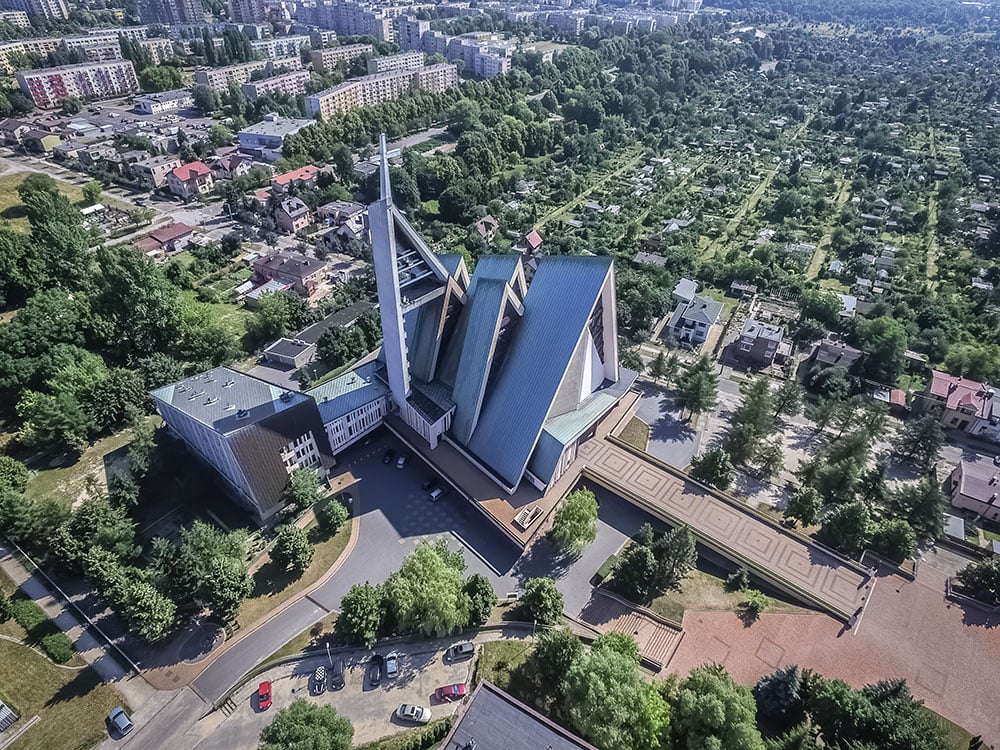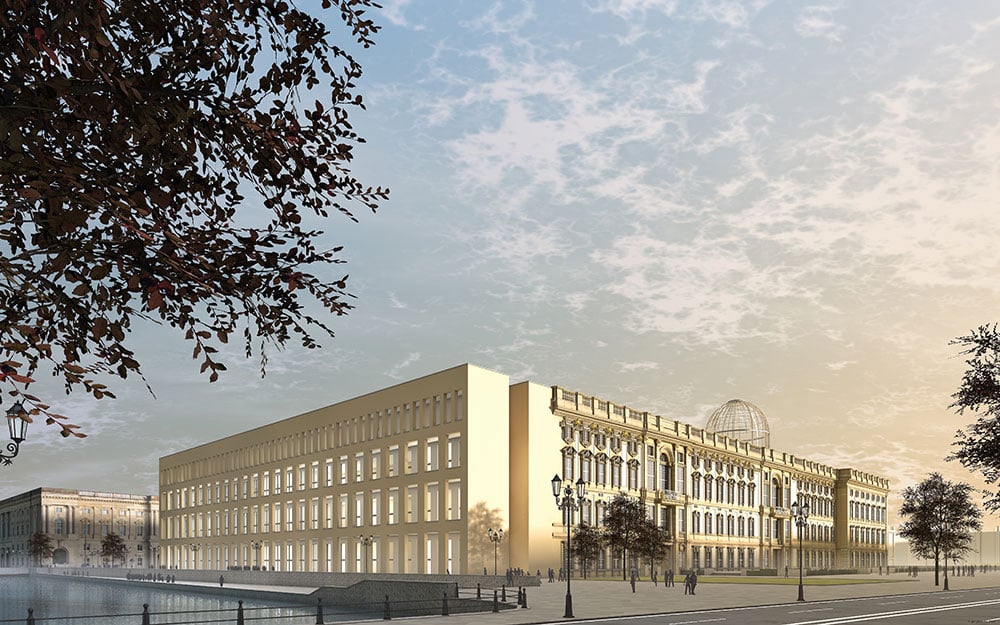Arch of history: what the ruins of Palmyra reveal about conflicting visions of the East and the West
If you’ve had a conversation with a critically minded artist, architect or theorist during the past 50 years or so, it’s likely they’ll have told you something about the death of monumentality. The utopian fantasies and totalitarian excesses of the 20th century may have found their natural expression in obelisks, plazas, towers and skyscrapers. But the “democratic” tastes of the 21st century ought properly to incline towards humbler, more ephemeral forms: pop-up innovation hubs rather than Palaces of Culture or triumphal arches. Of course, the critically minded theorist will tell you, monumentality still does get done. But it’s kitsch stuff, fit for tinpot dictators and parvenu oligarchs. Here, in the West, we’re much more sophisticated and cutting-edge. We only do bronze and marble and columns if we’re being ironic. Through the Power and Architecture season, and especially via the conference, The Centre Cannot Hold? New Monumentality, Neo-Modernism and Other Zombie Urban Utopias, which kicks off the season, the notion that the monument is a zombie form limited to non-Western necromancers will be rigorously challenged.
In Architecture in the Age of Stalin: Culture Two — illicitly self-published in 1980 behind the Iron Curtain — the influential architectural historian Vladimir Paperny argues that Russian architectural culture oscillates between two variants: Culture One (horizontal, constantly in motion, aesthetically sparse), which can be most straightforwardly identified with the Russian avant-garde of the 1920s; and Culture Two (vertical, static, aesthetically opulent), identified with the Stalin years.
Boris Johnson stood in front of a gleaming classical ruin on Trafalgar Square, shouting something about ‘defiance’ and ‘the barbarians’
If we want to understand how power and architecture work together, we might begin by asking how Culture One and Two fit into today’s world. Is it right, for instance, to think of the “West” as living in a version of Culture One, possessed of dynamism and sophistication and freed of utopian modernist narratives? As for the “East”, Paperny himself has expressed uncertainty about whether these categories can be neatly applied to Russia any longer, with its plethora of new, post-socialist monuments. One thing is certain: to begin to understand how power and architecture work in a globalised economy, we don’t need to turn to Moscow, Astana, or even Beijing. There is much to consider right here in London.
Just a few weeks before he and his Conservative party were ousted from power in London, the city’s Mayor Boris Johnson stood in front of a gleaming classical ruin on Trafalgar Square, shouting something about “defiance” and “the barbarians”. The ruin was the central section of a decorative arch in Palmyra, a Roman-era oasis city in the Syrian desert; the original section of the arch had been blown to pieces by ISIS during its ten-month long occupation of the site.
During the last week of March 2016, Palmyra was recaptured by the Syrian Army and its multinational coalition of allies, backed by heavy Russian airpower.
On Trafalgar Square, then, this replica fragment of Palmyra was raised as a piece of monumental war propaganda, a good old-fashioned “arch of triumph” in Johnson’s words, London’s first for nearly two hundred years. A triumphal arch raised in the central square of the capital city of one state to honour a military victory won by another two states: states, it’s worth noting, to whom the UK is openly hostile, having cut diplomatic ties with Syria and imposed extensive economic and political sanctions on both that country and Russia.
It wasn’t only the geopolitics of Johnson’s Palmyra arch that seemed fishy. It didn’t look quite right, either. It was made to two-thirds scale, it turns out, and 3D-printed from photographs in an Italian marble quarry. It was flanked by burly, square-jawed security men with earpieces. In all of its airbrushed, over-securitised, media-hyped slickness, it brought to mind another Russian association, with Moscow during the reign of Yuri Luzhkov, Mayor between 1992-2010. Luzhkov spent 18 flamboyant years in power filling Russia’s capital with so-called “sham replicas” of historical monuments, while simultaneously managing – by some counts – to demolish even more of the city’s historical fabric than did Stalin.
The Trafalgar Square arch is, it transpires, the gateway to a whole range of topics relevant to Power and Architecture: Russia, architectural aesthetics, “ruin porn”, empire and the rebuilding of post-war East Europe. Russia is well placed to play a role in the reconstruction of Syria. Following ISIS’ retreat, the world reentered Palmyra through Russian eyes. Russian drones swooped through the ruins. Russian sappers combed through them for explosives. Russian construction and engineering firms are now lobbying to secure contracts for the mammoth task of rebuilding Syria’s infrastructure.
Then, on 5 May 2016, Valery Gergiev, Russia’s highest profile maestro, arrived in Syria, together with the symphony orchestra of the Marinsky Theatre in St Petersburg. The orchestra played Bach, Prokofiev and Shchedrin in the Roman amphitheatre. Putin spoke by video-link on a giant screen. His favourite cellist, Sergey Roldugin of Panama Papers fame, delivered a long solo from a Shchedrin opera. As the cello played, the giant video screen showed footage of Russian planes and tanks causing victorious explosions in the desert. British Foreign Secretary Philip Hammond said the concert was “tasteless”.
Was the whole of Syria now going to be rebuilt in this tacky, 3D-printed, Luzkhov-Johnson theme park aesthetic?
The London arch, too, elicited a muttering of consternation. Was the whole of Syria now going to be rebuilt in this tacky, 3D-printed, Luzkhov-Johnson theme park aesthetic? Some – such as the Guardian’s art critic Jonathan Jones – went so far as to proclaim that “Palmyra must not be fixed”. Instead of over-restoring Palmyra’s monumental ruins, they should be preserved in the current extent of their ruination: ‘It is always more moving to see the real stuff of the past, however damaged, than to see a faked-up approximation.”
Now, the rebuilding of monuments and historical sites always necessitates taking some liberties with “authenticity”. It is always politicised and never uncomplicated. But it can bring profound and lasting joy, pride and cohesion to places devastated by war. I know this, because I’m from Warsaw. My grandparents told me stories about how they organised brigades of students to rifle through the rubble of Warsaw’s Old Town after WWII. About how they dusted down surviving bricks, so that they could be used again rather than discarded. About how the un-reusable bulk of the rubble was processed in special, purpose-built kilns so that new bricks would be made from the same physical matter as the old ones. Overall, a tense but workable synthesis was forged: between sentimentality and modernity, technology and authenticity, purity and ideology.
Moreover, the untainted Palmyra of Jonathan Jones’s bourgeois ruin porn fantasy never existed. Palmyra is known in Arabic as Tadmur, originally a small settlement founded by French colonial administrators in the 1930s. The villagers of Palmyra, who had lived for centuries in the midst of the ruins, were moved there, so that French archaeologists could get on with the task of turning Palmyra into an untainted antique folly of the European imagination. From the 1960s onwards, as the government of the Syrian Arab Republic and later the Ba’ath Party flirted with the communist regimes of Eastern Europe, Polish archaeologists and conservationists increasingly took to work in Palmyra. Many of these conservationists, in fact, had learned their trade amid the ruins of Warsaw, or were taught by those who had.
Palmyra’s 15-tonne lion, a monumental consort of the pagan Arabian goddess al-Lat, was also blown up by ISIS in June 2015. The various parts of the lion may have been 2,000 years old, but it had stood in its complete form for less than 40. It was found in pieces by Polish archeologists in 1977. They put it back together and filled in missing parts, completing the most recent phase of the restoration project only in 2005. Indeed, a plaster cast of the lion of al-Lat was unveiled at the University of Warsaw on 1 April 2016, just days after the battle of Palmyra and two weeks before the 3D-printed Palmyra arch went up amid much greater fanfare in Trafalgar Square.
The Trafalgar Square arch was an attempt to cash in on the capital exuding from the ancient stone, to fashion power out of the ruins of monumental architecture
The spectacular ruins of Palmyra have captured imaginations, ignited passions, generated innumerable column inches, even re-routed the course of military operations. They have provided the impetus for all sorts of wheeling-and-dealing among myriad assorted “stakeholders” – from both “East” and “West” – seeking to drive their stakes into Syria’s future.
The Trafalgar Square sham replica arch was also an attempt to cash in on the capital exuding from the ancient stone, to fashion power out of the ruins of monumental architecture, thousands of years after the fact. In Vladimir Paperny’s terms, its effect was a clumsy fusion of the propagandistic crudity of Culture Two, and the pop-up superficiality of the post-monumental era. A reminder of the fact that the space of Culture Two – or some mutation of it – continues to span the entire globe, to hold sway over politics and aesthetics way beyond the boundaries of what we call the “New East”.
Text: Michał Murawski
Top image: Marc Veraart under a CC licence

